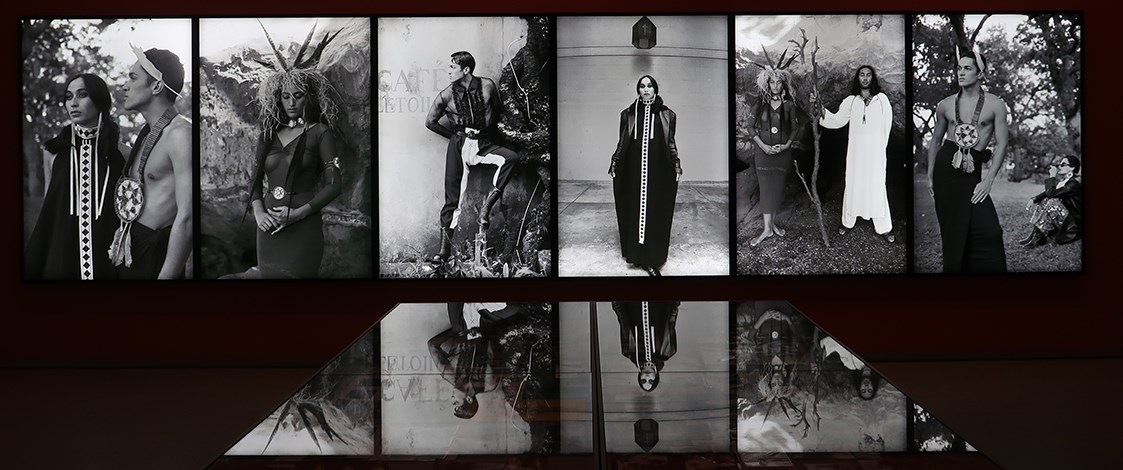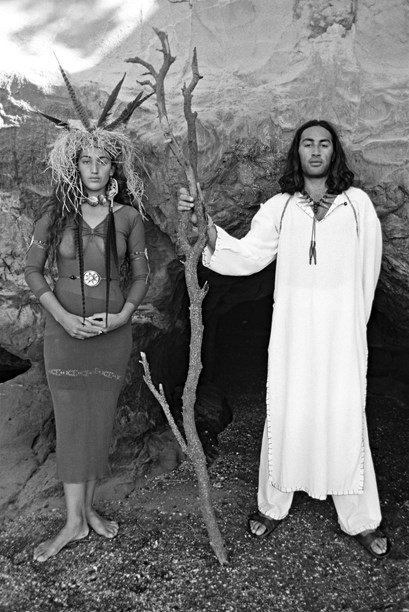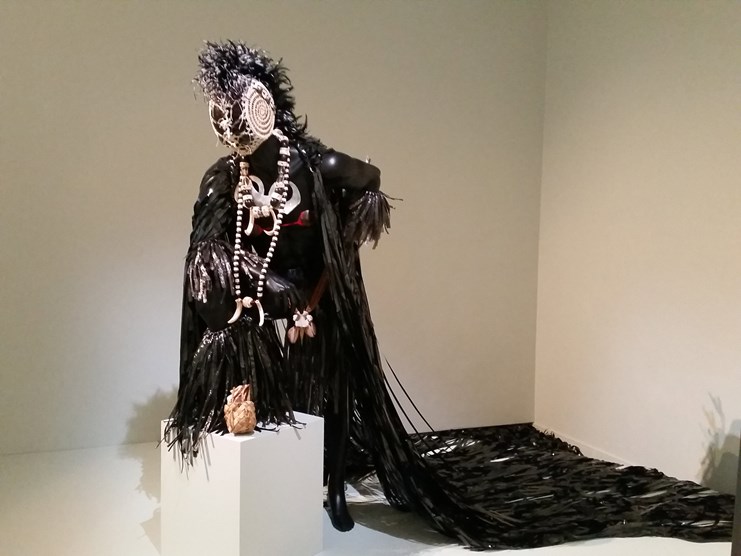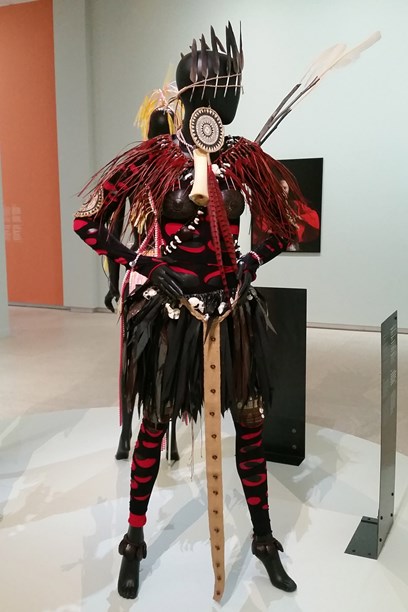Stories
Pacific Sisters
1991-

Pacific Wave was the title of the 1998 Sydney Biennale but it was a wave that had been climbing and building momentum in New Zealand fashion since the beginning of the decade. The Pacific Sisters were leaders at the crest of that wave that was sweeping across the region.
A decade of social and economic upheaval in the 1980s which included the Springbok Tour protests, the bombing of the Rainbow Warrior nuclear protest ship in Auckland harbour, the passing of the homosexual law reform bill and the economic revolution that followed the introduction of a neo liberal agenda and the stock market crash changed the face of New Zealand. In 1989 Fashion Quarterly magazine predicted the emergence of a distinctive local style. With our doors to the world flung wide open we needed to consider our identity, what our point of difference was on the world stage.
While mainstream fashion turned to the independent designers for a lead on this, urban Māori and Pasifika young people sought to create an identity that encapsulated their reality and aspirations.
Suzanne Tamaki talks about her dress 'Heroine' which she wore to Auckland's Hero Parade.
New Zealand-born children of immigrant parents, many had often never been to the original land of their families. Their challenge was to try to reconcile the values and cultural practice of home with their lived experience at school and in the city.

Bonny Proctor and Karlos Quartez modelling Pacific Sisters garments, 1993. Image © Vivienne Haldane.
The Pacific Sisters brought a unique perspective to the task of weaving together the threads of polynesian craft and culture with urbanism and activism.
The initial impulse came from a desire by Selina Forsythe (now Haami) who was a costume designer at Mercury Theatre and making under her own label La’ei, Suzanne Tamaki and Niwhai (Nephi) Tupaea who were making jewellery, to create a platform to show their work. They proposed to hold a fashion show, titled Te Hou Wairua Wahine, at the Powerstation in Auckland. At Selina’s invitation Rosanna Raymond was brought in to organise the event, while a model search brought Ani O’Neill, an art student at Elam, into contact with the others. From this small successful beginning a dynamic group of women (and some men) created an identity that could harness their individual talents into collective action. They called themselves Pacific Sisters to acknowledge a common goal to unite their Māori, Pacific Island and New Zealand European origins into a new Aotearoa Pacific identity. Sisters to counter the romanticised passive stereotype 'Dusky Maiden' and to denote the strength and power of women doing it for themselves.
Clinton Povey and Nephi Tupaea, 1992. Photos © Vivienne Haldane.
They brought together craft practices that they had learnt from their elders and their community with their own particular artistry and skill set to create garments and accessories. Using both natural and modern man-made materials; new, found, salvaged or repurposed, they were making clothes that spoke of an identity that was an authentic fit for their own urban aesthetics and lived experiences.
It was fashion as activism; communal making of inclusive and non-gendered one-off garments that were made for wearing and sharing through performances. These shows were often in the form of warehouse parties. Selina and Suzanne shared a warehouse in Nelson Street and Rosanna and her partner, photographer Kerry Brown, shared one in Kitchener Street, both became venues for their events. These were often big affairs with a huge number of collaborators looking after music, lighting, projections, dance, modelling, dressing and all the aspects of a live multi-media event. "It started out as fashion and had developed into performance and art," according to Feeonaa Wall, one of the Sisters.

'Kaitiaki with a K; Tāulaolevai Keeper of the water (Tuna)' is made from videotape that is woven using traditional methods.
Many of the garments are attributed to more than one sister – that might be because different sisters have made different parts of the original – jewellery, headdress, weaving, sewing etc but sometimes it just encapsulates the dynamism of fashion where a look might change over several iterations. Sharing ideas, cooperation and collaboration are an essential part of the Pacific Sisters story. So too is story and movement, more like PolyFest rather than a fashion parade Pacific Sisters garments are made to be shared with an audience through performance. They are strutting their stuff and looking for a response.
Feeonaa Wall says, "The garments have their own kaupapa; they are the beginning point, the music is the pulse, and the performers movements and actions thread the Pacific influence through the presentation."
Their work however was not universally well received. According to Caroline Vercoe writing in Arts Asia Pacific, "The mixture of traditional elements with strident sexiness proved controversial." Some of the strongest opposition came from Pacific elders. At the 7th Festival of Pacific Arts in Western Sāmoa in 1996, the contemporary nature of their proposed performance of Ina and Tuna led to their exclusion from the programme. They did however manage to organise a successful show, Motu Tangata, on the periphery of the main event, where they showed the work of 12 Pacific fashion designers from New Zealand.
Another noteworthy feature of the practice of the Pacific Sisters is the sense of fun that permeates their story. They all speak of their enjoyment of each other’s company and the shared creative processes of their making but it is in their playful use of language in naming their practice, their garments and events that a wry humour emerges.
Accessification is a term that the group devised to describe their process of layering the clothes, the addition of the mass of accessories, decorative elements, adornment, body oiling and grooming that go into preparing a look ready for presentation. Events have had names like Fresh Fash, Flash Fash, Tribe Vibe and the Extended Family Mix and EyeKonik. Garments have titles like '21st Sentry Cyber Sister', 'rePATCHtriation', 'Suga Frock' (perhaps created for the Fula Fuga Suga, an affectionate reference to a larger Polynesian woman in a floral dress).

The 21st Sentry Cyber Sister is a collaboration by four members of Pacific Sisters - Ani O'Neill, Niwhai Tupaea, Rosanna Raymond and Suzanne Tamaki. It was commissioned for the opening of Te Papa in 1998.
Their work and that of their collaborators became a catalyst for a diverse range of creative practice and events. In 1994 the Auckland Council invited Rosanna Raymond to create a Pacific fashion show which was later to become known as Style Pacifika and ran for 17 years. Digital image making by Pacific Sister Lisa Reihana, enhanced the performance of Ina and Tuna which they presented in 1995 as part of Interdigitate, an exhibition of new media and performance art at the Aotea Centre. Her digital work represented New Zealand at the Venice Biennale in 2017.
The exhibition Pacific Sisters: He Toa Tāera | Fashion Activists showcases and documents their journey from makers of urban street style and to creators of multimedia performances in warehouses, night clubs and art galleries. It highlights their engagement with many social issues that are as relevant in our society today as then – belonging, cooperation, collaboration.
Text by Doris de Pont. Banner image © Vivienne Haldane.
Last published April 2019.